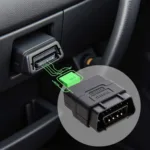OBD2 Mode 6, also known as the On-Board Diagnostic System Monitoring Test Results, provides access to the results of diagnostic monitoring tests performed by the vehicle’s onboard computer. This mode is particularly valuable for technicians and advanced DIYers troubleshooting complex issues in Ford vehicles. It delves deeper than standard OBD2 codes, offering a wealth of information about your Ford’s engine performance and emissions systems.
Decoding OBD2 Mode 6 Data on Your Ford
Instead of generic fault codes, Mode 6 presents detailed test results for various components and systems. This data can be overwhelming for the untrained eye. Understanding how to interpret this information is key to unlocking its potential. Here’s a simplified breakdown:
- TID (Test ID): Each component or system has a specific Test ID.
- CID (Component ID): Identifies the specific component within a system.
- Test Value: The actual result of the diagnostic test.
- Min/Max Limit: Acceptable operating ranges for the test value.
By comparing the test value to the minimum and maximum limits, you can quickly identify components operating outside of acceptable parameters, even if they haven’t triggered a fault code yet.
Common OBD2 Mode 6 Tests for Ford
Ford vehicles utilize a range of Mode 6 tests. Here are some frequently encountered ones:
- Catalyst Monitoring: Evaluates the efficiency of the catalytic converter.
- Oxygen Sensor Monitoring: Checks the performance of oxygen sensors.
- EVAP System Monitoring: Tests the integrity of the evaporative emissions control system.
- EGR System Monitoring: Assesses the functionality of the Exhaust Gas Recirculation system.
Understanding these tests and their corresponding TIDs and CIDs allows you to pinpoint issues related to emissions, fuel economy, and overall engine performance.
Utilizing Mode 6 for Ford Diagnostics
OBD2 Mode 6 empowers you to:
- Proactively Identify Issues: Detect problems before they escalate into major repairs or trigger the check engine light.
- Confirm Suspicions: Verify the effectiveness of repairs or component replacements by observing changes in test values.
- Gain In-depth Understanding: Obtain detailed insights into your Ford’s engine and emissions systems for informed decision-making.
OBD2 Mode 6 Ford: A Powerful Tool for Experienced Users
“Mode 6 is invaluable for experienced DIYers and technicians,” says John Miller, a certified Ford master technician. “It provides a deeper level of diagnostic capability compared to simply reading fault codes.”
However, navigating Mode 6 requires a solid understanding of automotive systems and diagnostic procedures. While powerful, it’s not for beginners. If you’re unsure about interpreting Mode 6 data, consult a qualified mechanic.
Conclusion
OBD2 Mode 6 provides a wealth of information about your Ford’s engine and emissions system health. By understanding how to interpret this data, you can proactively identify issues, confirm repairs, and gain deeper insights into your vehicle’s performance. However, due to its complexity, it’s essential to have a solid understanding of automotive systems before diving into Mode 6 diagnostics.
For further information on specific OBD2 codes or scanner recommendations, explore other resources available on OBDFree. Learn more about obd2 misfire counter or explore the features of the craftsman obd2 scanner 20899.


